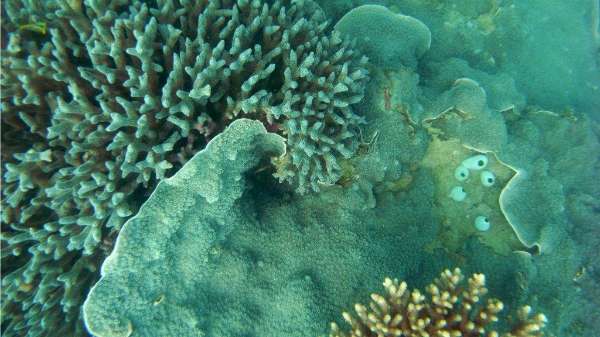Underwater cameras revealed a diverse coral reef environment in a never-before-studied part of the Kimberley. Credit: Andrew Halford
The weather gods conspired to provide a rare chance to survey a remote and rarely visited section of north Kimberley reef recently, with footage that will inform the future study of reefs through climate change.
Department of Parks and Wildlife (DPAW) researchers and Wunambal Gaambera traditional owners took advantage of the rare weather conditions to visit East Holothuria Reef, about 30km from the tip of Bougainville Peninsula, to conduct coral surveys.
They uncovered a flourishing and extremely biodiverse reef system, resplendent with corals and fishes, in a spectacular and never-before-studied part of the Kimberley's underwater world.
"It is right in the top corner of the Bougainville Peninsula where wind-against-tides creates very rough sea conditions for much of the time," says DPAW research scientist Andrew Halford.
"But we lucked-in with glass-off weather during neap tides—it was like a good perfect storm."
The team traversed multiple 100-metre transects of the reef placing a camera on the bottom every 10 metres, which took photos every five seconds to record the diversity of the coral community.
Such footage will be used as a benchmark at monitoring sites across the north Kimberley, to enable conservation managers to study how reefs change and respond to different circumstances such as storms or a changing climate.
"We will be establishing long-term monitoring sites in the Kimberley that we can go back to and keep track of over time," Dr Halford says.
"We'll be able to see whether healthy reef communities can adapt to changing conditions over time."
The big picture
The DPAW survey was part of a much larger examination of Kimberley benthic communities conducted by the Australian Institute of Marine Science, CSIRO, and the WA Museum, under the WA Marine Science Institute-managed Kimberley Marine Research Program.
These organisations are using large research vessels to study the diversity of the Kimberley marine benthic environment. The DPAW survey complimented their work by assessing shallower near-shore areas that are inaccessible to the larger boats.
Dr Halford says traditional owners are also playing an important role in monitoring these remote marine systems.
"As well as providing traditional knowledge of these areas, the idea is that eventually traditional owner groups will go out and do the surveying themselves," Dr Halford says.
"They can take the footage and then the images can be sent to experts for analysis."
Provided by Science Network WA
This article first appeared on ScienceNetwork Western Australia a science news website based at Scitech.
























